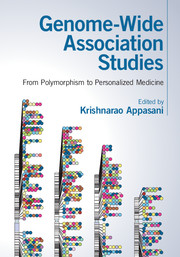Book contents
- Frontmatter
- Dedication
- Contents
- List of contributors
- Forewords
- Preface
- List of abbreviations
- Part I Genome-wide association studies
- Part II Genome-wide studies in disease biology
- 5 Genome-wide association studies of body mass index
- 6 Identification of myocardial infarction-susceptible genes and their functional analyses
- 7 Admixture mapping for disease gene discovery
- 8 Genome-wide association analysis in schizophrenia
- 9 Epigenome-wide association studies in neurodevelopmental disorders
- Part III Single nucleotide polymorphisms, copy number variants, haplotypes and eQTLs
- Part IV Next-generation sequencing technology and pharmaco-genomics
- Part V Population genetics and personalized medicine
- Index
- Plate section
- References
7 - Admixture mapping for disease gene discovery
from Part II - Genome-wide studies in disease biology
Published online by Cambridge University Press: 18 December 2015
- Frontmatter
- Dedication
- Contents
- List of contributors
- Forewords
- Preface
- List of abbreviations
- Part I Genome-wide association studies
- Part II Genome-wide studies in disease biology
- 5 Genome-wide association studies of body mass index
- 6 Identification of myocardial infarction-susceptible genes and their functional analyses
- 7 Admixture mapping for disease gene discovery
- 8 Genome-wide association analysis in schizophrenia
- 9 Epigenome-wide association studies in neurodevelopmental disorders
- Part III Single nucleotide polymorphisms, copy number variants, haplotypes and eQTLs
- Part IV Next-generation sequencing technology and pharmaco-genomics
- Part V Population genetics and personalized medicine
- Index
- Plate section
- References
Summary
Introduction
Mapping disease genes by admixture linkage disequilibrium (MALD) is a method that exploits observed associations between disease and ancestry. The sources of these observed associations generally fall into two categories: (1) environmental exposures, including factors such as diet, cultural practices and pathogens, and (2) heritable genetic risk modifiers. In a genome-wide association study (GWAS), association between a genetic marker and the disease are sought for, and any statistically significantly associated marker is inferred to be near a risk-modifying genetic variant. By contrast, a MALD study maps disease genes by identifying associations between ancestry and disease. Thus, loci with a statistically significantly different ancestral origin, when compared to the rest of the genome or to a control group, will be inferred to harbor a risk-modifying genetic variant. Additional research can then be carried out to identify the causal variant responsible for the observed association. The size of the associated region in a GWAS or MALD study is dependent upon the extent of genetic linkage at the locus in question.
Genetic linkage is fundamental to genetic association studies as a means to narrowing the search for causal variants, by identifying a chromosomal region associated with disease. When two markers are physically near each other on a chromosome, they are more likely to be inherited together, because there is a smaller chance of a crossover between the two during meiosis. The initial source of LD is mutation, in that a new allele arising at a locus by mutation necessarily occurs on a single chromosome, and is thus associated with all alleles carried on that specific chromosome (Bateson and Kilby, 1905; Morgan, 1910, 1911). In successive generations recombination breaks up this original chromosome, but even after 5000 generations – roughly the age of fully modern humans – chromosome segments of an average length of 20 kb will be inherited unbroken with probability less than 0.0001 (Matise et al., 2007). Random drift of allele frequencies, and selection for advantageous alleles against deleterious alleles, contribute to this process, in a complex and extensively studied pattern (Ohta, 1982; Sober, 1993; Keightley and Otto, 2006; Palaisa et al., 2004). As populations age, they acquire more variants and have more opportunity for recombination, which results in shorter blocks (or haplotypes) of LD, while younger populations tend to have longer LD blocks and fewer common variants (International HapMap Consortium et al., 2007).
- Type
- Chapter
- Information
- Genome-Wide Association StudiesFrom Polymorphism to Personalized Medicine, pp. 89 - 105Publisher: Cambridge University PressPrint publication year: 2016



